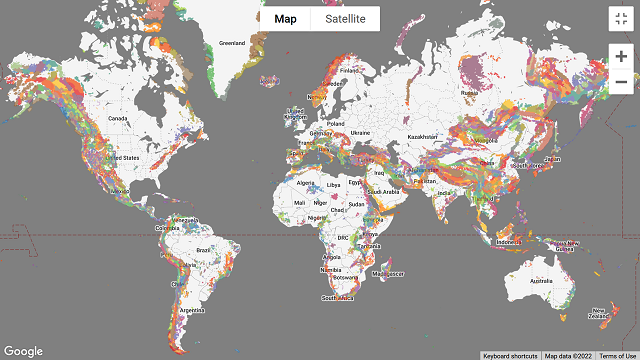GMBA Mountain Inventory v2.0 - A hierarchical inventory of the world’s mountains for global comparative mountain science
In April 2022, GMBA released a significantly updated and expanded version of its global mountain inventory, which now consists in 8616 mountain polygons.
This latest release, version 2.0, introduces a hierarchical classification of the mountain ranges of the world, which allows for the partitioning of mountain systems into smaller ranges and subranges and enables spatially explicit and comparative mountain research across scales.
In addition, the construction of the mountain range polygons is the result of a semi-automated approach described in Snethlage et al. (2022), where rivers form the borders between contiguous mountain ranges and the outer borders of the mountain systems correspond to a new, more generalized mountain definition.
The inventory is available for unrestricted download as a series of GIS shape files on the dedicated EarthEnv page. The files come in two main versions: ‘standard’, where the mountain extent corresponds to the new mountain definition, and ‘broad’ where the mountain extent encompasses all mountain definitions available on the Global Mountain Explorer. Both versions include a layer with all overlapping mountain ranges at different levels, a customized selection of major mountain systems, and a layer with only the smallest mapping units (the basic level). Both versions are associated to extensive attribute tables with information ranging form the polygon extent to the polygon’s name in various languages. Some of the information, including the full hierarchical path associated with each mapping unit and the unit’s Wikipedia link, is also displayed online.

In addition to the layers themselves, two tools are provided to explore and work with the downloadable shapefiles: the R package gmbaR, which directly reads and loads the shape files from the internet for further analysis, and the Excel GMBA Selection Tool, which includes a visually attractive rendering of the entire hierarchical tree, showing the relationship between the 8616 mountain polygons included in the inventory.
The development of this new dataset is described in detail in a paper published on 1 April 2022 in Nature Scientific Data.
Citation: Snethlage, M.A., Geschke, J., Spehn, E.M., Ranipeta, A., Yoccoz, N.G., Körner, Ch., Jetz, W., Fischer, M. & Urbach, D. (2022). A hierarchical inventory of the world’s mountains for global comparative mountain science. Nature Scientific Data. https://doi.org/10.1038/s41597-022-01256-y
Corresponding dataset: Snethlage, M.A., Geschke, J., Spehn, E.M., Ranipeta, A., Yoccoz, N.G., Körner, Ch., Jetz, W., Fischer, M. & Urbach, D. (2022) GMBA Mountain Inventory v2. GMBA-EarthEnv. https://doi.org/10.48601/earthenv-t9k2-1407

